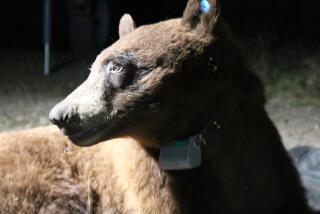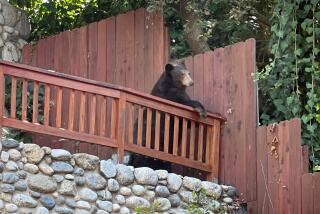
- Share via
MAMMOTH LAKES — Steve Searles is not really a cop, not really a civilian; he lives in limbo between those two worlds.
And, man, does he live. Think of him as the Serpico of the Sierra, a little snarly and gruff and frayed around the edges — a ponytailed ex-surfer turned mountain man. A bit of a hillbilly intellectual without much formal schooling, a void in his resume that both flusters and propels him.
“It’s haunted me my whole life,” he confesses.
There are lots of contradictions to this 60-year-old wildlife officer, lots of ironies and surprising qualities that make him more than another town character, and worthy of a memoir.
Searles has carved out a niche and a career as Mammoth Lakes’ “bear whisperer,” a protector of the wild things that roam the night: the ubiquitous bears, deer, coyotes and all manner of high-country cat. He protects the residents and the 2.5 million annual visitors too, though they have the numerical advantage. They also have guns and cars … warm beds and cozy, muffin-scented kitchens.
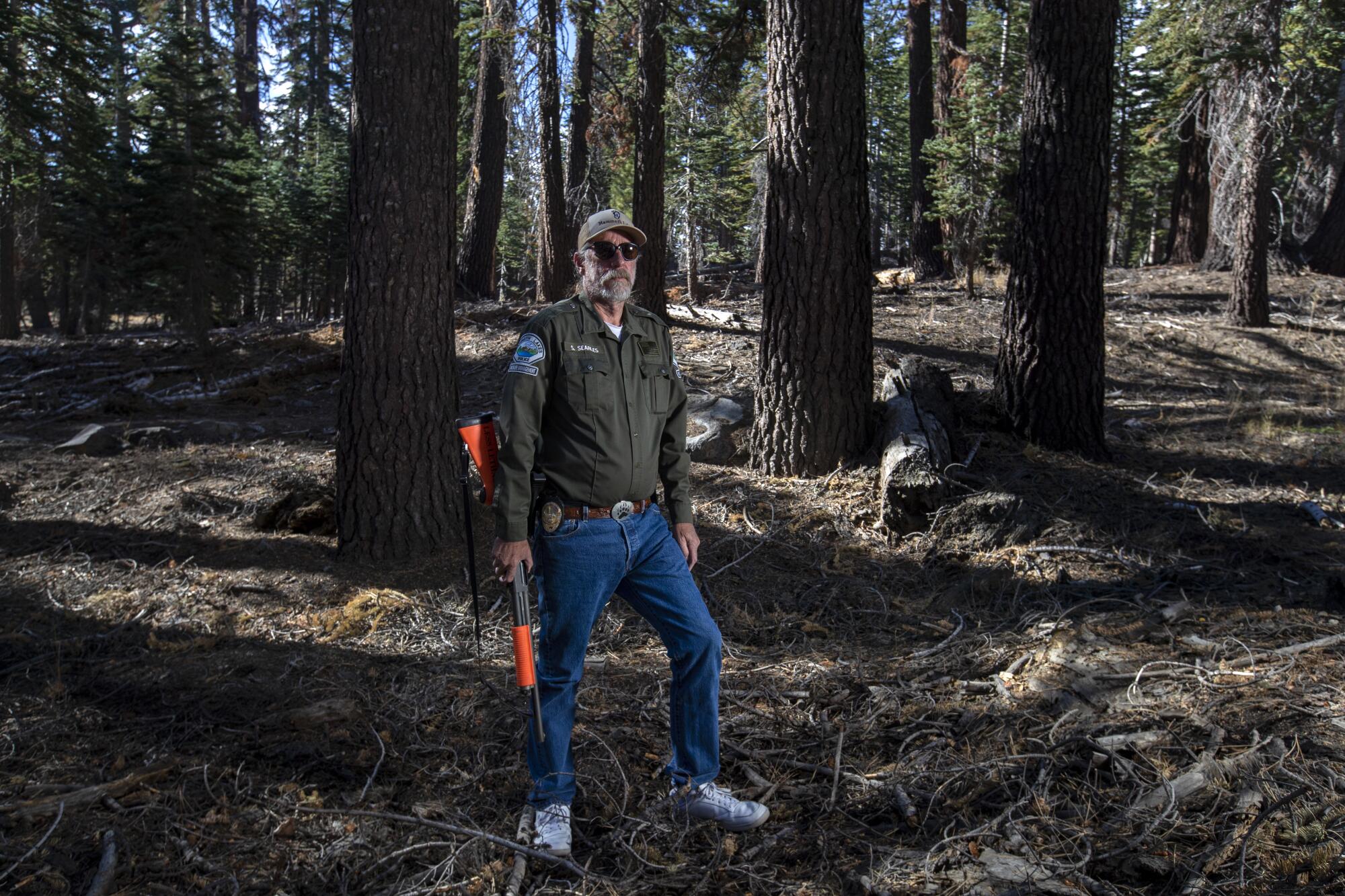
The wildlife sense this. They want decent food and cozy cabins too. Sometimes, they help themselves.
Back in the 1990s, when he was first hired as go-to guy for Mammoth’s critter overpopulation, it was the intrusive coyotes and raccoons that Searles handled. Mammoth Lakes had thousands of the trespassers under houses and cabins — mean and clever rascals that he trapped and removed before turning his efforts in 1996 to another nuisance, the black bears.
The bears were sweeter souls but even bigger presences, some topping 600 pounds. After a break-in, there’d be scat everywhere.
The police chief hired him — as a temp — to rid the ski village of half the big vagrants, who’d made a habit of plowing through restaurant Dumpsters and frightening the city folks from L.A. and San Francisco who came here to wallpaper the place with $100 bills. The fed-up police chief told Searles, who had a reputation as one of the region’s top hunters and trappers, to kill 16 bears.
“Right, chief,” Searles said. “On it.”
But along the way, he learned something about the bears, and in turn he learned even more about himself.
“Dead bears learn nothing,” he said. “If you kill one, another will come in from the mountains to replace it.”
An outside-the-box approach, based largely on stern voice commands, would lead to global recognition, an Animal Planet show, scores of fans and, he says, even a few stalkers.
His obsession and his long hours might also have cost him friendships and a long marriage to his wife, Debra, who recently packed up and left.
‘A grizzly bear is an apex predator; he will eat the tire off your truck. All a black bear wants to do is mow your lawn.’
— Steve Searles
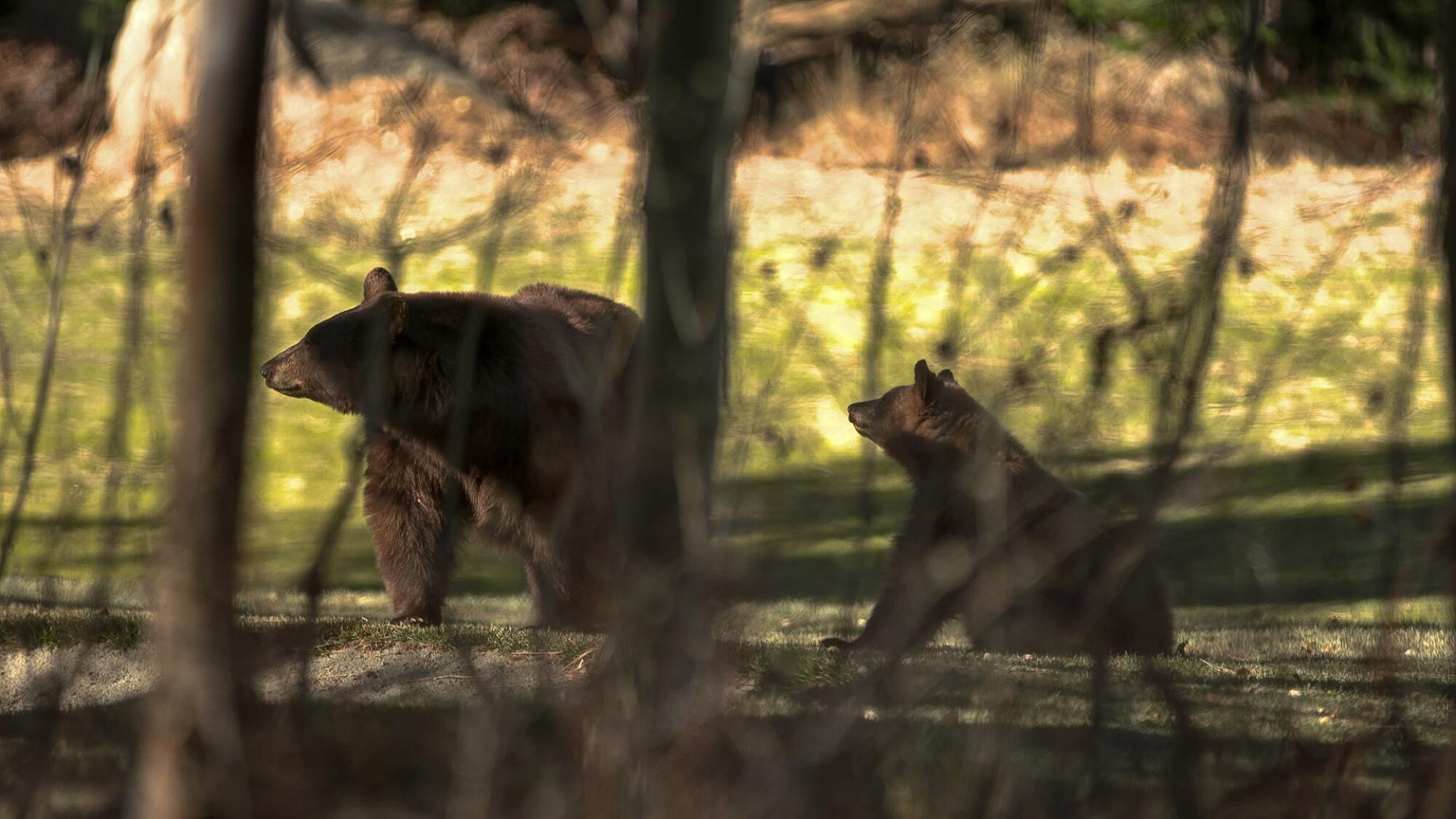
Yet, Searles is still here, still patrolling the shorelines where the bears tend to congregate, chasing them off the roads where they are in mortal danger, scolding them back into the woods and away from traffic with his trademark “Bad bear! Bad bear!” commands — along with a few other tools in his kit, such as air horns, fireworks and the occasional pepper ball.
“I’m not really the bear whisperer,” he says. “I’m more the bear yeller.”
But he’s more than that. He’s a party on wheels, glib and loaded with rough-edged charisma, mocking his buddies, making fun of himself more than anybody else.
“I’m lazy like Tom Sawyer,” he says of getting residents to adopt his methods. “I got everybody to do my work for me.”
Admittedly, he’s sometimes better with the bears than he is with people.
“Training the bears was easy,” Searles says. “Training the people was hard.”
An Orange County kid
Born in Torrance and raised in Orange County, Searles quickly tired of the area’s bustle and bloat. In 1976, at the age of 17, he headed to the mountains on the advice of a buddy.
“I’m driving up through the high desert; it’s arid and not what I’d expected,” he remembered. “And then there it was: Mammoth.”
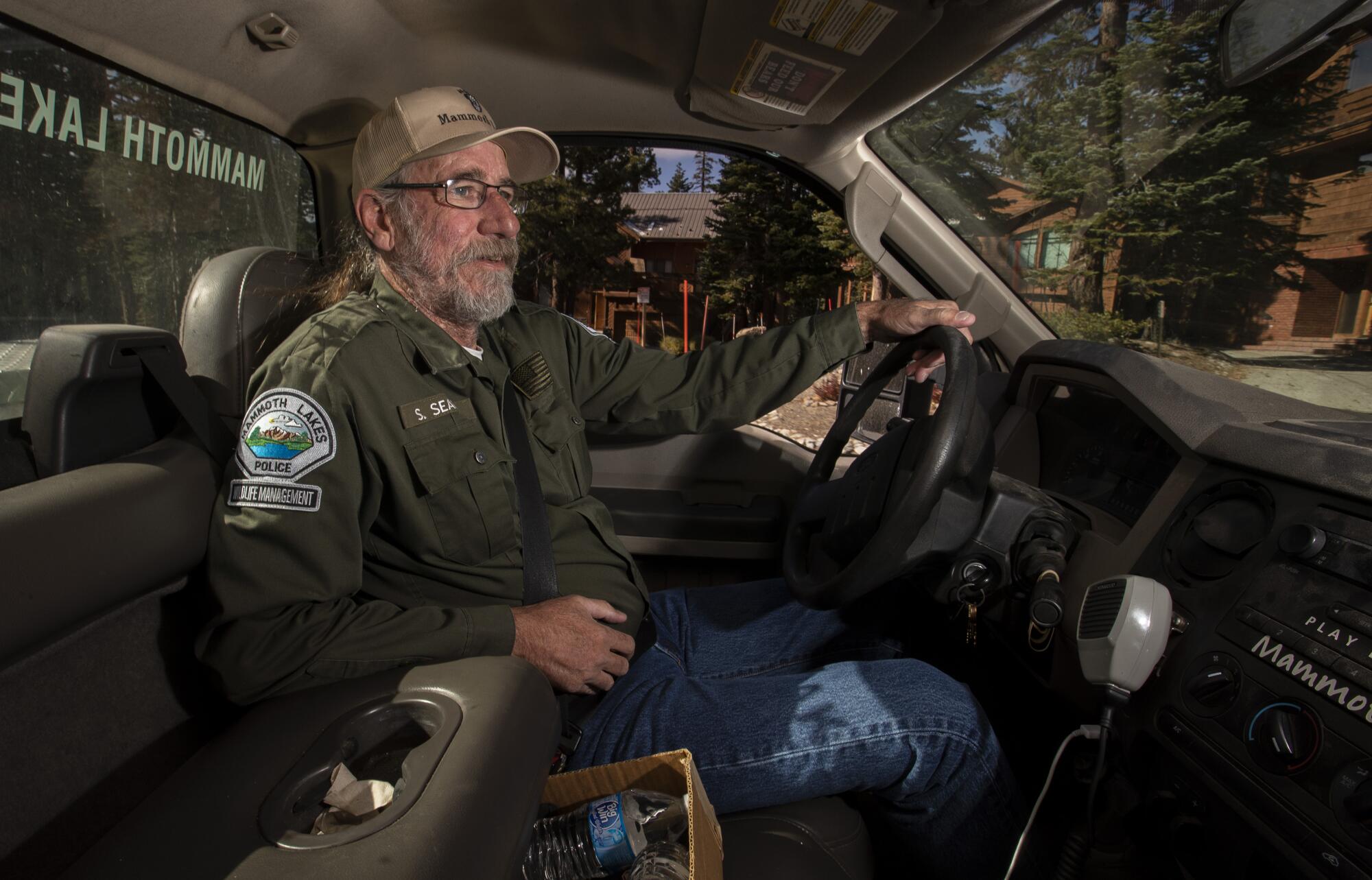
Searles acclimated quickly, buying a cowboy hat, a dog, a truck. He worked construction awhile, cleared trees to build roads, and became one of the settlers who grew the tiny mountain village into one of the West’s premier ski destinations.
“We were lost-soul hippies from the ’60s,” said Louise Dessert Inder, who arrived the same year and became a town fixture and a longtime friend.
“Steve was always super mellow,” she remembers. “He was always a low-key guy.”
Mammoth Lakes was merely a forest hamlet back then — so heavily wooded that they felled 1,500 trees just to carve out Main Street.
In his off time, the former Orange County surfer/dropout adopted the rhythms of the Eastern Sierra, embracing the beauty and bloody pleasures: trapping and hunting, including bear, elk, deer.
Is this a hobby he now regrets?
You might think so, yet he insists it gave him the tools he needed to later handle the bears, to learn their habits and homes, when they’d retreat to their dens for the winter, how they hunted, what they needed to survive.
“I’m a real weirdo,” he says. “If I do it, I overdo it.”
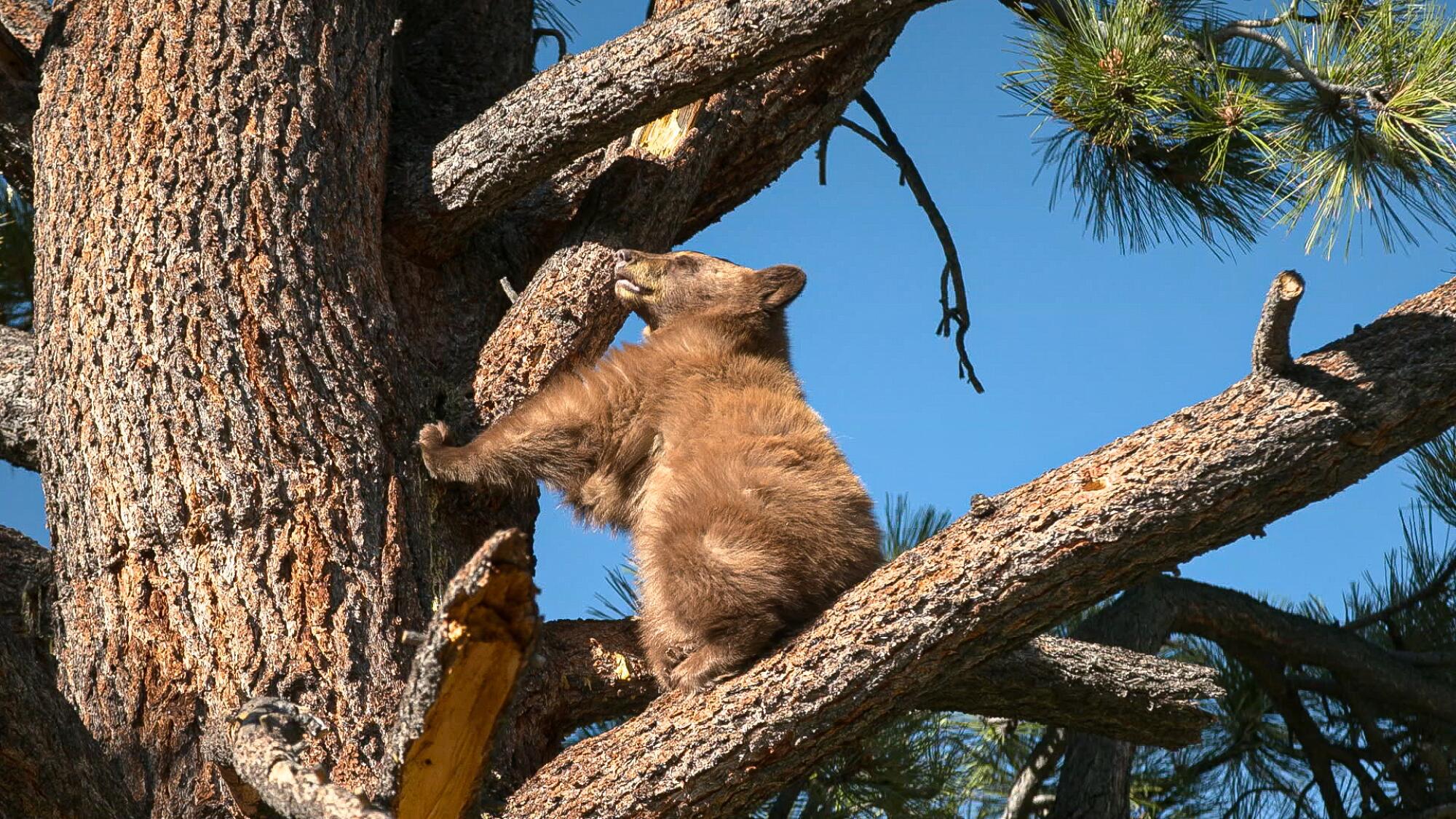
So he didn’t rush the bear-hunting assignment, taking months to chart them and plot their domains. He named them according to their appearances: Big Red, Half Nose, One Ear.
He’d stalk them too, climbing trees, even sneaking into their dens.
“When they would lie down to sleep, I would lie down to sleep,” recalls Searles, who once curled up under some giant pines only to discover he’d been sleeping on a village of angry ants.
He had plenty to study. California’s black bear population is bold and healthy, nearly tripling over the last 25 years. The California Department of Fish and Wildlife estimates 30,000 to 40,000 black bears live here, the most in the nation and twice as many as in Montana.
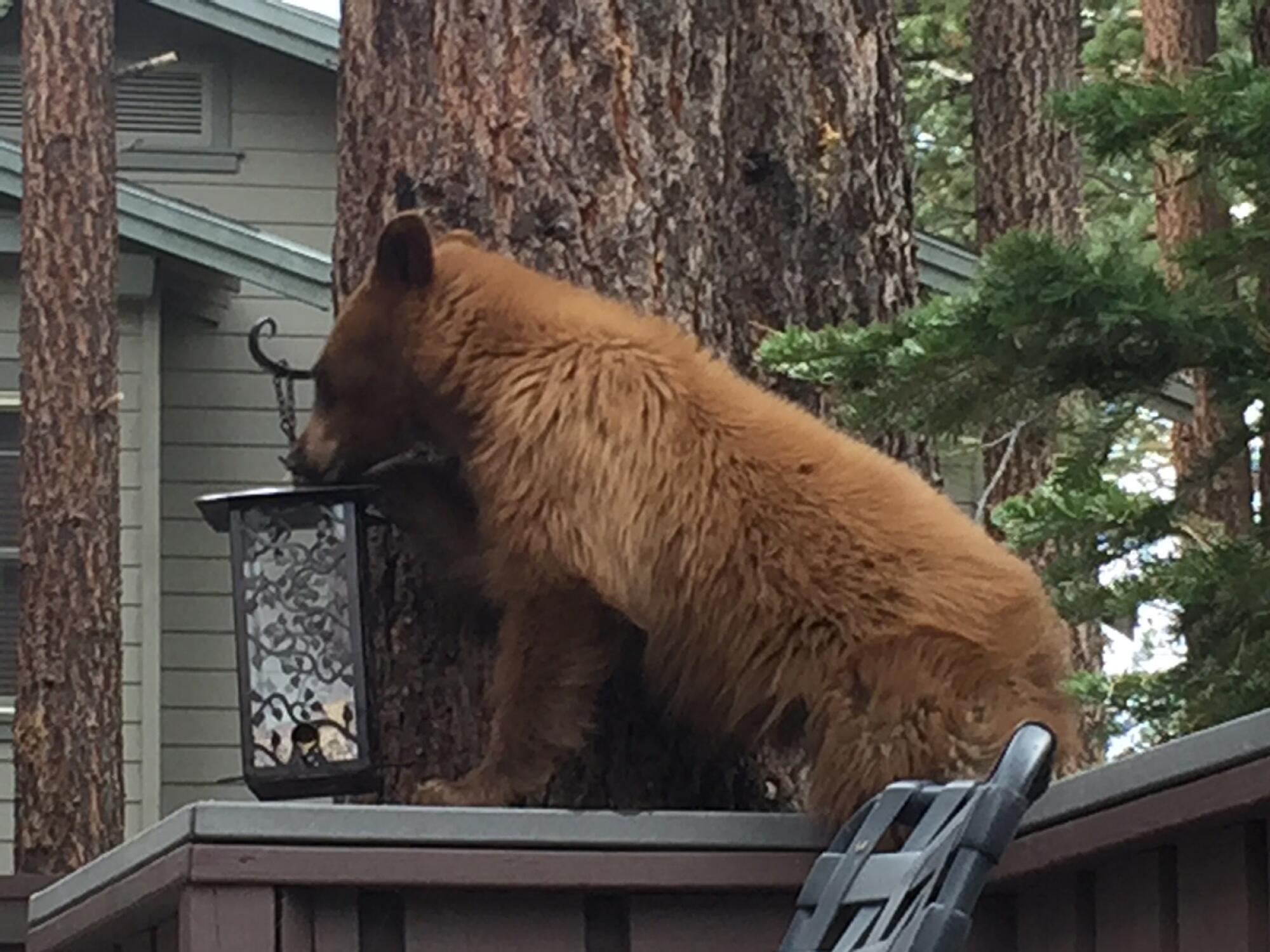
The bears mean no harm, generally, a trait Searles picked up on early. But he knew that open access to food scraps and bird feeders had led to bear congestion and damage to homes and property, drawing a backlash among residents.
Bears don’t eat; they gorge, typically 22 hours a day in the pre-winter season.
They will gnaw a tail light, or pick at a seam on a car till they can get to the food inside; occasionally, they activate an air bag, wreaking havoc when they can’t wiggle out. In many ways, they’re smarter than dogs, Searles says, and surprisingly adept at doorknobs and latches, or slamming Dumpsters to the ground to break a lock.
“If they had thumbs, they’d be driving these cars away,” says Mammoth Lakes Police Lt. Eric Hugelman, who oversees Searles.
They are clever yet cartoonish, their eagerness a liability. Searles once had to tackle a cub to remove a Costco snack jar stuck on the young bear’s head.
“Even a cub is 10 times stronger than I am,” he says respectfully.
Ideally, as winter nears, the bears get fat, really fat — blotto on berries, acorns and leaves, because the fatter they get, the luckier they get romantically.
A healthy ursine male, Searles learned, builds a layer of pure white fat, thick as a pillow, to get him through the winter. Females find this attractive, for, in some internal Darwinian dating metric, a robust male means mama’s offspring will be equally robust.
So they eat and eat, which is a black bear’s lot in life and the thing that gets them in trouble with their human neighbors, though black bears are happy eaters, not angry ones. They are omnivores who hunt meat only when they come across a discarded cheeseburger or a bucket of ribs.
“A grizzly bear is an apex predator; he will eat the tire off your truck,” Searles says. “All a black bear wants to do is mow your lawn.”
Once Searles realized they were “the tie-dyed hippies” of the animal kingdom, his work seemed less daunting. But he did pick up on a significant pecking order that would shape his approach.
His “aha!” moment came late one night in 1996 as he studied them at the town dump. He was watching a group of the bears feed when the diners suddenly darted off into the woods. Moments later, a 600-pound bear — nicknamed Big — emerged from the forest.
Searles realized then that, although they are docile, the bears had a chain of command.
“Big taught me that if you’re tough you shouldn’t have to carry a gun,” he says.
That led to his aggressive yet respectful relationship with the bears, built on knowledge, not bullets.
Not everyone bought in
“Hogwash,” some said, including bear experts who couldn’t accept the findings of a self-trained wildlife officer.
As he was getting going in the late ’90s, even some town folks mocked his more humane, touchy-feely approach.
“Bad bear! Bad bear!” they’d jeer from the porches as Searles scolded a trespasser back to safety.
But rarely had they encountered anyone so stubborn.
“My ignorance and lack of education … if I had sat down and read a lot of books, I never would’ve put myself out there,” he explains.
His obsessive nature didn’t hurt. By 1997, a year into his bear program, Searles was speaking to civic groups; he worked with restaurants to lock their trash bins; he charmed and scolded and pleaded. Ski towns can be tricky towns; blue-collar ethos mixed with white-collar excess.
Eventually, though, Mammoth bought in. The ski resort bought him a truck. In 2004, the town hired him on permanently.
His results spoke for themselves. Residents and visitors didn’t like seeing the poky and mirthful bears trapped, darted or killed, so Searles’ peacenik approach, featuring a combo of voice commands, air horns and firecrackers, slowly gained converts. Even the media, including this newspaper, took note. Animal Planet featured him in his own show, “The Bear Whisperer.”
His career has hardly been storybook. With no filter, and generally distrustful of authority, he got on the bad side of one police chief, who took his badge away over a dispute about staying in touch on patrol.
Never a go-along sort, Searles said the incident was political; the town reinstated him after supporters swarmed a meeting, saying the bear problem had gotten worse in his absence.
“I think residents began to realize he knows what he’s doing,” says Inder, his longtime friend.
In Mammoth, all this has led to a cultural shift. Thanks to Searles, bumper stickers now urge: “Don’t feed our bears,” hinting at a family dynamic. On the fairways, golfers have learned to play around the bears, going over and around, rather than panicking and calling 911.
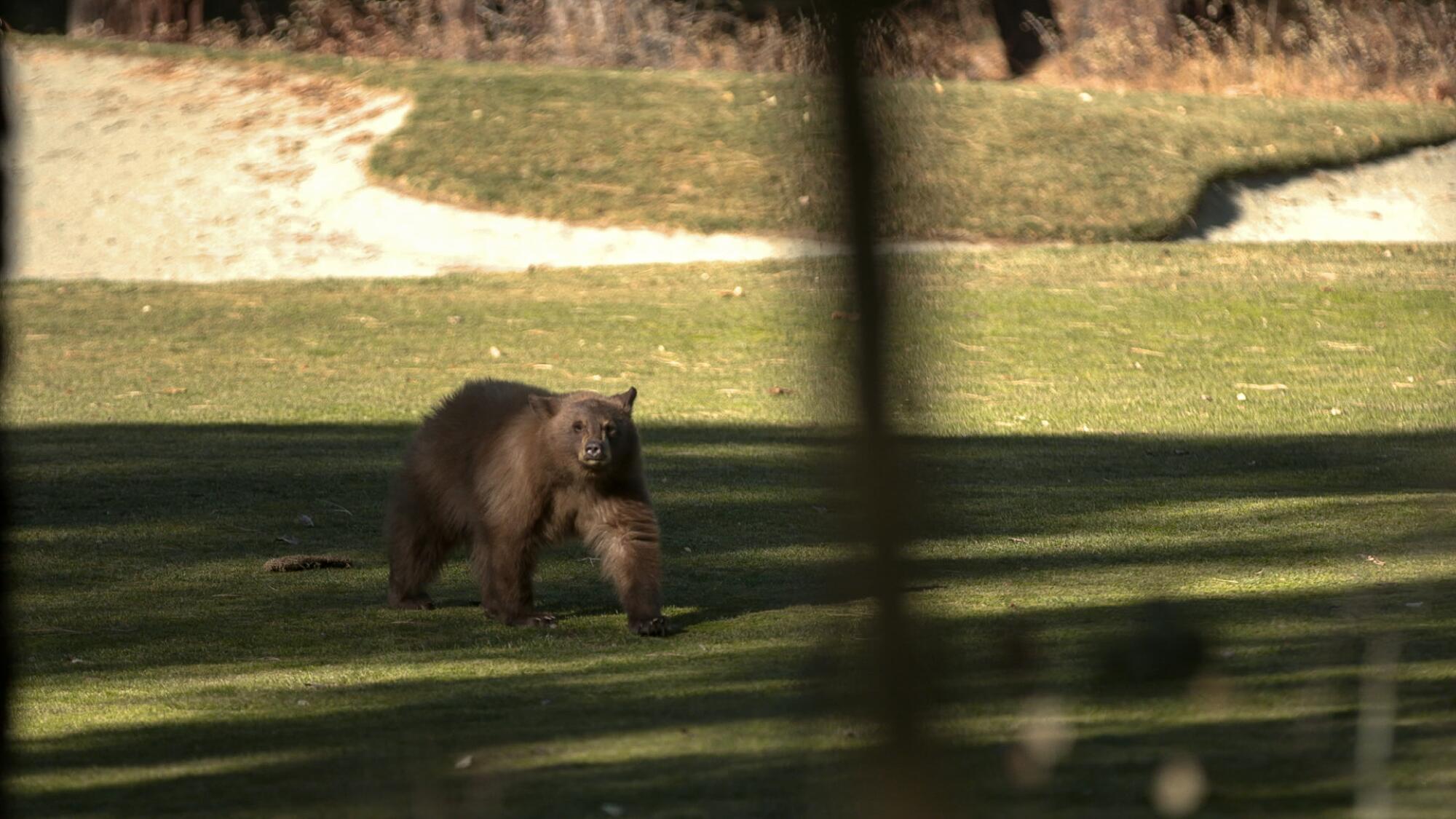
“One thing Steve has done is made sure locals and visitors don’t feed our bears, which ensures they are well-behaved bears,” said resident Cynthia Hayes.
(Not every place is as far along: In October, the Canadian town of Penticton euthanized five black bears that were getting into garbage that residents left out.)
“Steve trains the bears to be almost invisible,” Hayes said.
Two years ago a very young bear lost its mother. Searles became the adoptive mom, making sure it wasn’t abandoned while making sure it knew boundaries. Bears have been known to wander into the local Vons and just start snacking.
In fact, food control became foremost in the efforts to control the bear population. Bears that gorge on scraps tend to be fatter and breed more. With trash bins secured here, the bear population dipped to what the grasses and wildflowers could sustain. The population — 30 bears lived in Mammoth when he started — has dropped to a dozen or so, as birth rates declined a little each year.
Even the bears seem grateful. In all his time, Searles has never been hurt, nor has one even taken a swipe at him.
“I certainly would’ve if I were them,” he says.
Winning professional respect proved trickier. In 2000, Searles spoke to the International Assn. for Bear Research and Management, a symposium of biologists and wildlife officers in Jackson Hole, Wyo. In his opening statement, the ponytailed expert scolded the audience over the general lack of respect for bears and their emotions. For emphasis, he laced his presentation with F-bombs.
“I just was who I was,” he says.
Bears have emotions? The audience was amused, then appalled. The presentation ended abruptly, clouded with contention.
“Get me out of here,” Searles told his travel agent wife, hoping to hop the next plane home.
But the mob’s reaction didn’t reflect the experts’ individual interest. The next day, as he was about to bolt for the airport, the world’s most renowned bear experts began to corner him one by one, handing him their cards, impressed with his boots-on-the-ground insights.
They wanted to know more.
“It’s hard to know if the bears are his spirit animal, or it’s the other way around,” says Peter Alagona, an associate professor of environmental studies at UC Santa Barbara.
Alagona speaks with admiration for Searles’ findings, which he says were ahead of the pack.
“He came to conclusions that, for me, more decorated researchers took longer to figure out,” Alagona says.
The lessons of man and beast
These days, Searles remains a nationally recognized expert who has helped over the years with bear problems on the East Coast and in Canada.
Curious lay people also seek him out, crediting him with doing God’s work. For some, he has achieved folk hero status.
“He looks like Jesus and he’s got that deep baritone voice,” says former Mammoth Police Chief Dan Watson, Searles’ boss for almost five years. “Steve has become kind of legendary.”
Yet, being a folk hero isn’t what Searles set out to do; he simply enjoys the work.
“I’ve been through four or five generations of bears,” he says now. “I know them since they are cubs.”
For how much longer? Who knows? He’s been through five mayors, 12 town managers, dozens of skeptics, hundreds of bears.
“I get tired this time of year,” he says, as the animals go on a pre-winter feeding frenzy. “But I’m just the luckiest guy ever.”
“In all my dreams of how this would go, it’s been 10 times better,” he says.
Not that luck is ever-present. He’s dealing with the fallout of his divorce, the quiet of the house after a long marriage, some major repair bills from a flood that happened while he was away — the house filling like a bathtub before the flood was found.
Investments and rental properties help set off what his annual salary of $62,000 can’t cover.
A self-confessed news junkie and voracious reader, Searles also says he misses following current events, which he now avoids because of the confrontational political tone.
He can’t help but apply the lessons of the wild to some of society’s current standoffs. Such as, how when we don’t understand strangers, our first inclination is to fear them, and maybe shoot them dead. That we’re often quicker to hate than to accept, to listen, to learn.
Meanwhile, retirement nears, yet Searles says it holds little appeal.
“My lifestyle is my job, my hobby,” he says. “All the things people travel to go do, I do at my job.”
At night, he jots notes for a memoir, each chapter on a different Mammoth bear and the things the animal taught him … Big Red, Half Nose, One Ear, Scout.
Bears are characters, you know, much like him. Stubborn. Willful. Playful. Strong.
Little by little, Searles continues finding his place in that kingdom; not atop it — within it — still prowling it late at night as would a watchman or a town crier, an ex-hippie kid with an extraordinary understanding of the mountains and the creatures that call it home.
And when they sleep, he sleeps.
More to Read
Sign up for Essential California
The most important California stories and recommendations in your inbox every morning.
You may occasionally receive promotional content from the Los Angeles Times.

